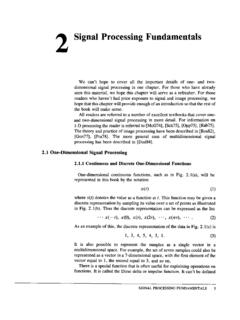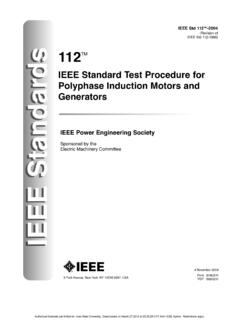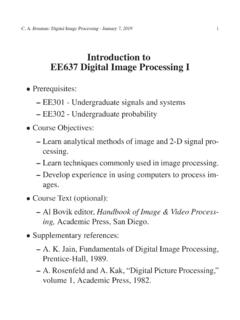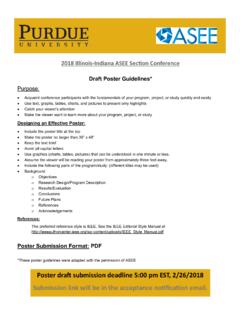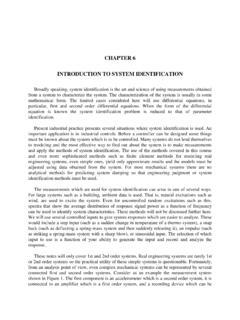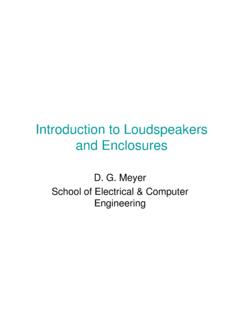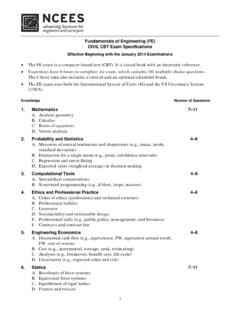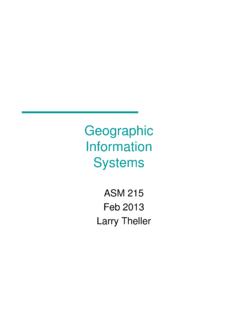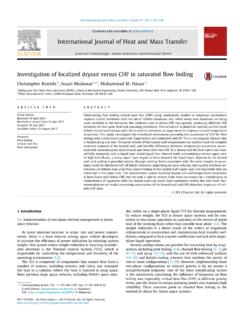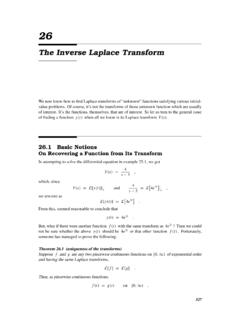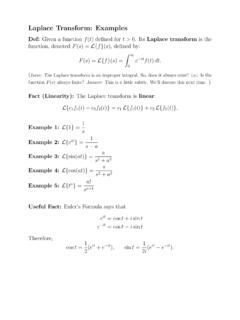Transcription of ECE 382 Fall 2012 The Laplace Transform Review
1 ECE 382 fall 2012 The Laplace Transform ReviewbyStanislaw H. Zak1 DefinitionThe Laplace Transform is an operator that transforms a function of time,f(t), into a newfunction of complex variable,F(s), wheres= +j , as illustrated in Figure 1. The operatorLdenotes that the time functionf(t) has been transformed to its Laplace Transform , denotedF(s). The Laplace Transform is very useful in solving linear differential equations and hence-f(t)L-F(s) =L(f(t))Figure 1: Schematic representation of the Laplace Transform analyzing control obtain the Laplace Transform of the given function of time,f(t),1. multiplyf(t) by a converging factore st.
2 This is a factor that decreases to zero astime increases to infinity;2. Integratef(t)e stwith respect to time between the limits 0 and to obtain theLaplace Transform off(t),F(s) =L(f(t)) = 0 f(t)e stdtThe lower limit of integration is 0 , rather than 0, to account for the effect of instanta-neous energy transfer .1-F(s)L 1-f(t) =L 1(F(s))Figure 2: Schematic representation of the inverse Laplace Transform above definition of the Laplace Transform is also referred to as theone-sidedorunilateralLaplace Transform . In the two-sided, or bilateral, Laplace Transform , the lowerlimit is . For our purposes the one-sided Laplace Transform is we want to reverse the operation and take the inverse Transform , back to the timedomain, we writeL 1(F(s)) =f(t).
3 Taking the inverse Laplace Transform is illustrated in Figure we are using the one-sided Laplace Transform , we define all functions, whoseLaplace transforms we compute, to be zero fort <0 . To proceed, we recall the definitionof the unit step function,u(t),u(t) ={1 ift 00 ift < unit step function is also called the Heaviside 1 Find the Laplace Transform off(t) =e atu(t),whereais a real constant. A graph off(t) fora= 3 is shown in Figure 3. We haveL(e atu(t)) = 0 e ate stu(t)dt= 0 e (a+s) above integral exists if<(a+s)> 3: A plot ofe 3tu(t).The region of thes-plane for which the Laplace Transform exists is called theRegion ofConvergenceand abbreviated ROC.}
4 Sinces= +j , the ROC, in our example, is theregion in thes-plane where0<<(a+s) =<(a+ +j ) =a+ ,that is, the region where > a. Proceeding with the integration, we obtainL(e atu(t)) =( 1a+se (a+s)t) 0 =( 1a+se (a+s) ) ( 1a+se (a+s)0 ).Forsin the ROC, the first term tends to zero. Hence,L(e atu(t)) =1s+a3 Using the Laplace Transform of the exponential function, we can easily find the Laplacetransform of the unit step. Indeed, ifa= 0, thenf(t) =e atu(t) =u(t). Hence,L(u(t)) =1s(1)2 Linearity Property of the Laplace TransformThe Laplace Transform of the sum, or difference, of two functions of time is equal to thesum, or difference, of the transforms of each function, that is,L(f1(t) f2(t)) =L(f1(t)) L(f2(t))(2)Indeed,L(f1(t) f2(t)) = 0 (f1(t) f2(t))e stdt= 0 f1(t)e stdt 0 f2(t)e stdt=L(f1(t)) L(f2(t)).
5 The Laplace Transform of the product of a real or complex constantKand a time functionf(t) is equal to the product of the constant and the Transform of the time function, that is,L(Kf(t)) =KL(f(t)).(3)Indeed,L(Kf(t)) = 0 Kf(t)e stdt=K 0 f(t)e stdt=KL(f(t)).The above two properties can be represented in the formL(Kf1(t) f2(t)) =KL(f1(t)) L(f2(t))Example 2To find the Laplace Transform off(t) =Ku(t),whereKis a constant, we can use (3) and the Laplace Transform of the unit step, givenby (1), to obtainL(Ku(t)) =KL(u(t)) = 3We will use the linear property of the Laplace Transform to find the Laplacetransform off(t) = sin , recall the Euler formula,ej t= cos t+jsin ,e j t= cos t jsin the second of the above expressions from the first one and dividing the resultby 2jgivessin t=ej t e j ,L(sin t) =L(ej t e j t2j)=L(12j(ej t e j t)).
6 Applying to the above (3) yieldsL(sin t) =12jL(ej t e j t).Applying now (2), we obtainL(sin t) =12j(L(ej t) L(e j t)).We then use twice the formula for the Laplace Transform of the exponential to getL(sin t) =12j(1s j 1s+j ).Performing algebraic manipulations givesL(sin t) = s2+ 2 Similarly, we obtainL(cos t) =L(ej t+e j t2).Hence,L(cos t) =ss2+ 253 Laplace Transforms of DerivativesWe will now show thatL(df(t)dt)=sF(s) f(0 )whereF(s) =L(f(t)) andf(0 ) is the initial value off, that is, the value offat 0 . Thus,differentiating in the time domain corresponds to multiplyingF(s) bysand then subtractingthe initial value off(t). To derive the above formula, we apply the definition of the Laplacetransform,L(df(t)dt)= 0 df(t)dte stdt,(4)and then evaluate the integral by integrating by parts.
7 Recall that the formula for integratingby parts can easily be derived from the formula for the derivative of the product of twofunctions. We use the notation,u =du(t) , we have(uv) =u v+uv .Integrating the above and rearranging gives u v=uv uv .(5)We letu =dfdtandv=e applying (5) to (4), we obtainL(df(t)dt)=e stf(t) 0 0 f(t)( se st) thatf(t) is Laplace transformable, the value ofe stf(t) att= is zero. Hence,the right-hand side of the above reduces toL(df(t)dt)= f(0 )+s 0 f(t)e stdt=sF(s) f(0 ).Thus, we showed that differentiation in the time domain corresponds to an algebraic opera-tion in the Laplace Transform of the first derivative of a time function, we can easilydetermine the Laplace Transform of higher-order derivatives.
8 Indeed, to find the Laplacetransform ofd2f(t)dt2, we letg(t) =df(t) ,L(g(t)) =G(s) =L(df(t)dt)=sF(s) f(0 ).(6)Note thatd2f(t)dt2=dg(t) ,L(df2(t)dt2)=L(dg(t)dt)=sG(s) g(0 ).Substituting into the above (6) givesL(df2(t)dt2)=s(sF(s) f(0 )) g(0 ).Observing thatg(0 ) =df(0 )dt, we getL(df2(t)dt2)=s2F(s) sf(0 ) df(0 )dtSuccessively applying the above arguments, we can obtain the Laplace Transform of then-thtime derivative,L(dfn(t)dtn)=snF(s) sn 1f(0 ) sn 2df(0 )dt sdn 2f(0 )dtn 2 dn 1f(0 )dtn 14 Solving Differential Equations Using Laplace Trans-formWe now illustrate how to use the Laplace Transform and inverse Laplace Transform to solvelinear ordinary differential equations.
9 After taking the Laplace Transform of both sides ofa differential equation and performing required manipulations in thesdomain, we need toreconstruct the solution in the time domain. This is achieved using the inverse 4We will solve the following differential equation using the Laplace Transform ,2d2x(t)dt2+ 7dx(t)dt+ 5x(t) = 10u(t),subject to the initial conditionsdx(0 )dt= 1, x(0 )= 2,7whereu(t) is the unit step take the Laplace Transform of both sides of the differential equation to get2L(d2x(t)dt2)+ 7L(dx(t)dt)+ 5L(x(t)) = 10L(u(t)).Using Laplace transforms of time derivatives of a function of time and the Laplace transformof the unit step function, we obtain2(s2X(s) sx(0 ) dx(0 )dt)+ 7(sX(s) x(0 ))+ 5X(s) = into the above the initial conditions and rearranging gives(2s2+ 7s+ 5)X(s) =10s 4s 12 =10 4s2 ,X(s) = 4s2 12s+ 10s(2s2+ 7s+ 5)= 2s2 6s+ 5s(s2+ + )= 2s2 6s+ 5s(s+ ) (s+ 1).
10 (7)We now need to reconstruct the solution of the differential equation in the time domain. Inother words, givenX(s) we want to obtainx(t) in whichx(t) is zero fort <0 such thatX(s) =L(x(t)). Thus,x(t) =L 1(X(s)).To proceed, note thatX(s) as given by (7) is a rational function ofs, that is,X(s) is a ratioof two polynomials ins, in which the degree of the numerator with respect tosis smallerthan the degree of the denominator. Such a rational function is called strictly proper andcan be expanded into a sum of partial fractions by writing a term or a series of terms foreach zero of the denominator. We obtainX(s) =K1s+K2s+ +K3s+ 1.
